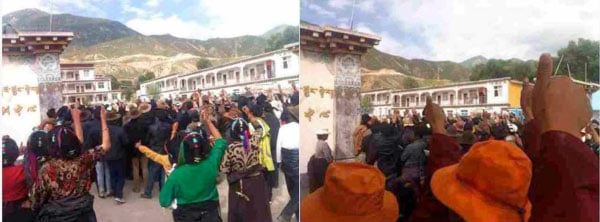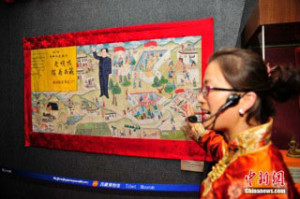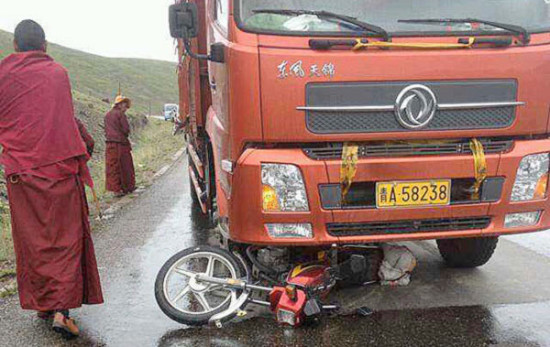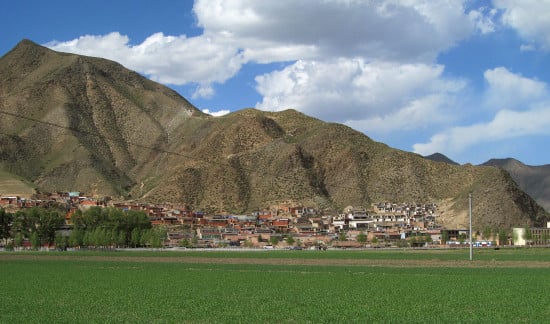Ten Tibetans injured after police open fire in Kardze, Tibet

Tibetan demonstrators in Sershul prior to the police shooting.
Around ten Tibetans were injured in Sershul, Kardze, Sichuan on August 12 after paramilitary police opened fire on a crowd of Tibetans protesting the detention of a respected village leader, according to Tibetan sources. The area, in the Tibetan region of Kham, is now under tight control, with local Tibetans including the elderly and children subject to interrogation, according to several Tibetan sources in exile.
Images from the area circulating on social media depicted Tibetans with what appear to be serious wounds on the head and torso following the incident in Loshu (Chinese: Luoxu) Township in Sershul (Chinese: Shiqu) county in Kardze (Chinese: Ganzi). For more please see the full ICT report here.
Tibetan environmentalist Rinchen Samdrup released from Chinese prison
Reports indicate that Rinchen Samdrup, a dedicated Tibetan environmentalist, has been released following four years of imprisonment. Samdrup, who was convicted on trumped-up charges of “inciting separatism,” was well known for organizing Tibetan environmental protection groups and launching reforestation projects. His brother, Karma Samdrup, remains in prison as he serves a 15 year sentence.
ICT: China’s human rights abusers should be barred from the United States
Building on recent United States travel bans imposed on human rights violators, the International Campaign for Tibet urges the U.S. government to act to restrict visa entry to Chinese officials complicit in human rights abuses in China and Tibet.
“The U.S. government can send a clear message: if Chinese officials violate the human rights of the Chinese and Tibetan people, they can’t visit the United States,” said Matteo Mecacci, President of the International Campaign for Tibet. “There is momentum to extend visa bans to human rights violators, and there is no reason China, the world’s largest abuser, should not be included. We value the freedom to travel as we value fundamental human rights. Visa bans are a tool that governments can use to discourage officials who would violate such rights.”
For more please see the full ICT release here.
New Chinese exhibition in Lhasa attempts to rewrite history on Dalai Lama

A Chinese tour guide shows visitors an image of Mao in a Tibetan landscape on display at a new propaganda exhibition in Lhasa this week. Image from the Chinese media.
The exhibition, geared towards a Chinese audience, opened in Lhasa on Monday (August 11), a time when the city is packed with mainly Chinese tourists. It featured an image of Mao standing in a Tibetan landscape among houses that display red flags, in a disturbing attempt likely to be distressing to Tibetans to assert the Chinese authorities’ ‘ownership’ of Tibet and the Dalai Lama and Panchen Lama lineages. ICT has released a full report on the subject here.
Report: 40 Tibetans detained in Darlag county

Monks inspect the scene of a fatal crash in Darlag, Tibet. (Image: RFA)
The detentions were the result of protests following a fatal car accident in which a Chinese driver hit and killed a Tibetan motorcyclist, according to Radio Free Asia. When friends and relatives of the deceased arrived at a police station to protest the release of the Chinese driver and his failure to pay the ordered compensation, armed Chinese police fought with the crowd and severely injured a number of Tibetans.
Tibetan Center for Human Rights and Democracy: Anti-corruption crackdown in Tibet must focus on human rights abuses
Commenting on the recent arrival of anti-corruption teams in the Tibet Autonomous Region, the Tibetan Center for Human Rights and Democracy [TCHRD] has called on Beijing to address long-standing human rights abuses in Tibet. The nationwide anti-corruption campaign has slowly come to focus on Zhou Yongkang, a former member of the Communist Party Standing Committee whose prime legacy was the institution of harsh crackdowns under the guise of “maintaining stability.” TCHRD states that “if the goal of the anti-corruption campaign is to address the causes of social unrest, it is doomed to fail unless the government stops supporting the wanton violation of human rights in Tibet.” For more please read the full TCHRD report here.
Observations from Amdo: Trip report from a traveler in Eastern Tibet

Sangchu, Tibet 2014.
A new ICT photo-story presents a vivid account in words and images of a visit by a foreign researcher to the eastern Tibetan area of Amdo earlier this summer. The foreigner, who speaks Chinese, gives his insights on the dramatic pace of change on the plateau, from urbanization and the coming of the railway to the impact of Chinese policies in the remote rural grasslands. The researcher connects the Tibetan landscape to its recent past and China’s policies: the protests at Labrang which resulted in a monk being tortured to death and so many still in prison; the stupa in Tsoe where the grandfather of the 7th Gungthang Rinpoche self-immolated in 2012; and the Chinese trinket-sellers cashing in on Tibet chic’ in a monastery town. The full report has been posted here.
“The Athlete”
The Athlete: Tibetan Stories 4 EN from Russell Avery on Vimeo.
Another installment of the “Tibetan Stories” series has been released by Russell Avery, Kestrel Media, and the International Center for Mental Health and Human Rights. This one features members of a Tibetan girls soccer team in Dharamsala as they practice and play, and connects their time on the field with their Tibetan identity and self-esteem. Earlier installments include The Monastery Cook and The Graduates.

